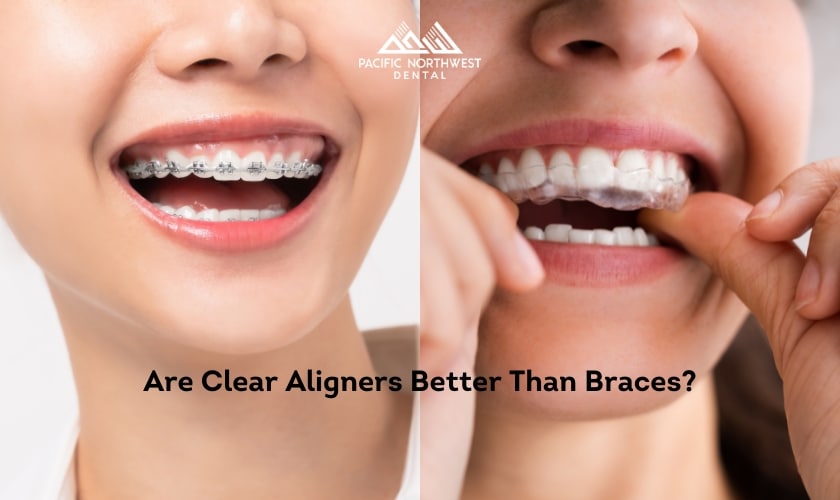
For many people, the dream of a perfect smile is clouded by the fear of traditional braces. The thought of metal brackets and wires can be a major turnoff, especially for adults. Thankfully, technological advancements have given us a near-invisible alternative: clear aligners. But with so many options available, the question remains: are clear aligners better than braces?
This comprehensive guide dives deep into the world of teeth straightening, exploring the pros and cons of both clear aligners and braces. By the end, you’ll be equipped with the knowledge to make an informed decision about your smile transformation journey.
The Truth About Straightening Teeth
Misaligned teeth are a common dental concern, affecting millions of people worldwide. While some may see it as a purely cosmetic issue, crooked teeth can actually impact oral health. They can be harder to clean, leading to an increased risk of cavities and gum disease. Additionally, misaligned teeth can affect your bite, causing jaw pain and difficulty chewing.
Fortunately, orthodontic treatment offers a solution. Whether through traditional braces or innovative clear aligners, these treatments gradually shift your teeth into their ideal positions, creating a healthier and more aesthetically pleasing smile.
Traditional Braces vs. Clear Aligners
Let’s get down to business! Here’s a breakdown of the two most popular teeth straightening options:
Traditional Braces
- Function: Braces consist of metal brackets bonded to each tooth, connected by an archwire that applies gentle pressure, gradually moving your teeth. Adjustments are made regularly by your orthodontist to maintain the desired movement.
- Effectiveness: Braces are highly effective in treating a wide range of orthodontic issues, from mild to severe crowding, gaps, and bite problems.
- Pros:
- Proven track record of success
- Effective for complex cases
- Relatively low cost compared to some clear aligner options
- Cons:
- Highly visible metal components
- Discomfort during tightening appointments
- Restrictions on certain foods
- More challenging oral hygiene maintenance
Clear Aligners
- Function: Clear aligners are a series of custom-made, removable plastic trays that gently shift your teeth into place. Patients wear each set of aligners for a prescribed time before switching to the next set in the series.
- Effectiveness: Clear aligners, particularly Invisalign, are most effective for mild to moderate cases of misalignment. They may not be suitable for severe crowding or complex bite issues.
- Pros:
- Nearly invisible appearance
- Removable for eating, drinking, and brushing
- Less discomfort compared to braces
- Fewer dietary restrictions
- Cons:
- May not be suitable for all cases
- Relies on patient compliance for success (aligners need to be worn for a specific amount of time each day)
- Higher upfront cost compared to traditional braces
Clear Aligners Better Than Braces
There’s no one-size-fits-all answer to the question of whether aligners are better than braces. The ideal treatment depends on several factors, including:
- Severity of your misalignment: For complex cases, braces might be the more predictable and effective option.
- Your lifestyle and preferences: Clear aligners offer increased discretion and flexibility, which may be appealing to adults or individuals who are self-conscious about traditional braces.
- Cost: While upfront costs for aligners might be higher, consider long-term expenses. Braces may require more frequent adjustments, potentially impacting the overall cost.
Making the Aligners vs. Braces Decision: Consulting Your Orthodontist
The best way to determine whether aligners are better than braces for you is to schedule a consultation with a qualified orthodontist. This dental specialist can assess your individual needs, perform a thorough examination, and recommend the most appropriate treatment plan based on your specific situation and goals.
Beyond Aligners Better Braces: Additional Considerations
Here are some additional factors to consider when making your decision:
- Discipline: Since clear aligners are removable, adherence to the recommended wear time is crucial for successful treatment.
- Oral hygiene: Maintaining good oral hygiene is essential with both braces and aligners. However, removing aligners for brushing and flossing can be easier.
- Treatment duration: Treatment time can vary depending on the severity of your case and the chosen
Are Clear Aligners Better Than Braces?
Treatment duration:
Treatment time can vary depending on the severity of your case and the chosen method. In general, braces may take slightly longer (18-24 months) compared to clear aligners (12-18 months on average). However, this is just an estimate, and your orthodontist can provide a more accurate timeline during your consultation.
Cost Considerations
The cost of both braces and aligners can vary depending on your location, the complexity of your case, and the specific treatment plan. While traditional braces often have a lower upfront cost, consider the potential for additional expenses with more frequent adjustments.
Clear aligners typically have a higher initial cost, but they may require fewer office visits. Some insurance plans may offer partial coverage for orthodontic treatment, so be sure to check with your provider.
Living Life with Your Chosen Treatment
Braces:
- Diet: Certain hard or sticky foods can damage braces, requiring adjustments or repairs. You’ll need to be mindful of your diet and avoid foods like nuts, popcorn, and hard candies.
- Activities: Individuals who participate in contact sports may need to wear a mouthguard to protect their braces.
Clear Aligners:
- Convenience: The removable nature of aligners allows for greater flexibility in your daily routine. You can easily remove them for eating, drinking (except for sugary beverages), brushing, and flossing.
- Maintenance: Taking care of clear aligners is relatively simple. Just rinse them with lukewarm water and a soft toothbrush.
Choosing between clear aligners and braces is a crucial decision. By understanding the pros and cons of each option and consulting with a qualified dentist, you can confidently embark on your journey towards a healthier, more confident smile. Remember, the “better” option is the one that best suits your individual needs and preferences.
